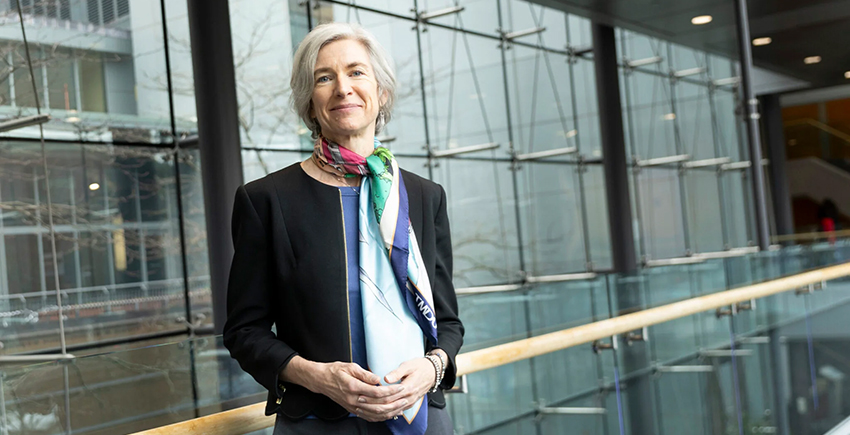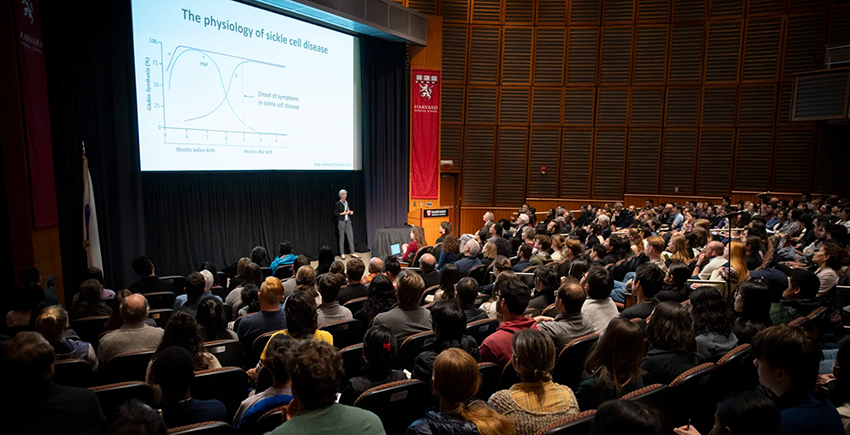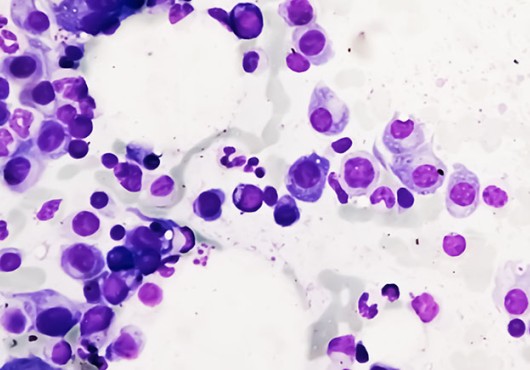
The world stands on the edge of an era when gene editing can address many serious ills plaguing humankind, according to Jennifer Doudna, whose work on the gene editing technique known as CRISPR-Cas9 earned her the 2020 Nobel Prize in chemistry.
But first, she said, there is a problem to solve: ensuring that as these technologies become approved to treat and even cure certain human diseases, they reach everyone who needs them.
In a pair of talks delivered last week at Harvard Medical School, Doudna delved into her laboratory’s latest endeavors to understand and improve CRISPR-based gene editing techniques so they can become cheaper to manufacture, easier to deliver into the body, and more effective at lower doses.
Such efforts reach for a future in which all patients can afford CRISPR-based therapies, instead of only the privileged; all health care facilities can deliver them, not just well-equipped urban teaching hospitals; and treatment can be done completely inside the patient’s body, without needing to remove and replace cells or suppress the immune system as current methods require, she said.
Sickle cell disease and beyond
Doudna applauded the 2023 FDA approval of a CRISPR-based gene editing therapy developed by Boston-based Vertex Pharmaceuticals and CRISPR Therapeutics to help those struggling with sickle cell disease. Preapproval studies showed it was very effective at reducing the severe pain that accompanies the life-threatening blood disorder.
Doudna said the advance shows how CRISPR-based therapies can address hard-to-treat ailments — but also highlights the hurdles that still stand in the way of widespread use.
The therapy, she said, uses a process similar to that of a bone marrow transplant. Blood stem cells are extracted from a patient’s bone marrow, genetically modified outside the body, and then reinfused into the marrow to produce blood cells that greatly reduce disease symptoms and dangerous complications.
That process, while groundbreaking, is physically challenging for patients, and expensive, with each treatment costing more than $1 million.
Together, those factors explain why only about 250 people worldwide have received experimental CRISPR-based therapies for any disease so far, Doudna said, even though sickle cell disease alone affects 90,000 to 100,000 people in the U.S. and millions globally.
“It’s exciting, but that’s quite a small number,” Doudna said.
The rise of CRISPR
Doudna delivered her talks, “The Biology and Technology of CRISPR-based Genome Editing” and “Rewriting the Future of Health Care with Genome Editing,” on April 10 and 11 in a packed Joseph B. Martin Amphitheater on the HMS campus. The talks marked the return of the century-old Dunham Lecture series after several years’ hiatus.
The event served as a reunion of sorts for Doudna — who received her PhD in 1989 from the Harvard Griffin Graduate School of Arts and Sciences in what is now the Biological and Biomedical Sciences program, studying in the HMS lab of Nobel laureate Jack Szostak — and her former teachers and mentors.

Doudna’s work on CRISPR-Cas9 genome editing technology with fellow Nobel Prize recipient Emmanuelle Charpentier and colleagues “forever changed the course of human, animal, and agricultural research,” said Stephen Blacklow, chair of the HMS Department of Biological Chemistry and Molecular Pharmacology in the Blavatnik Institute, who introduced Doudna on both days.
Blacklow added that Doudna has an “unsurpassed capacity to engage and inspire the next generation.”
The discovery of CRISPR-Cas9 in 2012 stemmed from basic scientific research into how bacteria fight off viruses. Researchers realized that a portion of the bacterial immune system contains molecules that precisely snip DNA at specific locations and developed that into the molecular scissors of CRISPR-Cas9 that allow the precise editing of human, plant, and animal DNA at specific locations.
The technique was immediately seen as a major advance. Scientists and clinicians began using it as a research tool and exploring it as a potential way to safely and selectively edit human DNA to tackle genetic diseases.
“CRISPR is great for research,” Doudna said. “The question is, how will we make it useful for treatments?”
Better delivery vehicles
Doudna said that if CRISPR is to achieve its promise of reducing human suffering, new ways of delivering it into the body are essential. She described several efforts underway in her lab and colleagues’ labs to create nanoparticle delivery systems that could, if perfected, relatively simply and cheaply deliver CRISPR-based gene editors to target cells in various tissues.
That would allow the gene-editing process to occur inside the patient’s body rather than in the lab, as occurs with the new sickle cell treatment. It would also avoid the expensive and arduous process of extracting cells from a patient’s body, engineering them to address a condition’s genetic causes, and then reinjecting them into the patient.
“How we can achieve in vivo [inside the body] genome editing, I increasingly think this is the bottleneck in this field,” Doudna said. “Broadly speaking, what we need to be addressing is how these editors are going to get into target cells in the body. It’s a really interesting, really big challenge, and there are many people working on it.”
Doudna expressed confidence that the problem of delivering gene editing therapy directly to patients’ cells is a solvable one. She described strategies to tackle the problem, including modified lentiviruses, lipid nanoparticles, and something called EDV — enveloped delivery vehicles. Moving from laborious, cell-based CRISPR delivery methods to fully or partially synthetic delivery methods could significantly reduce production cost and increase speed, she said.
On the horizon beckon even more ambitious goals, she said, such as packaging CRISPR with other molecular tools that prompt the body to make healthy versions of cells or proteins.
The array of creative ideas from researchers “makes me think that ultimately … we can come up with a strategy for a particle that will be both easy to make, easy to program, and be effective at delivering in vivo,” Doudna said.






